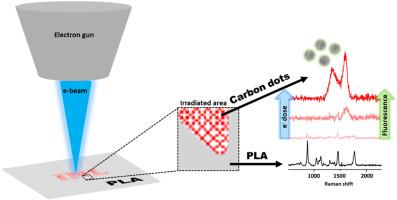原位电子束辐照在生物塑料上制备不可克隆荧光标签
IF 8.2
2区 材料科学
Q1 MATERIALS SCIENCE, MULTIDISCIPLINARY
引用次数: 0
摘要
伪造资产、文件和商品是一个日益严重的问题,假冒产品的扩散对经济产生重大影响,并对消费者的健康和安全构成重大风险。这凸显了对先进防伪技术的迫切需求。在这项工作中,我们展示了一种利用电子束辐照在聚乳酸(PLA)薄膜上创建不可克隆荧光标签的新方法。通过优化辐照条件,我们成功地控制了pla基薄膜表面碳点的形成,从而形成了发出荧光的碳点。通过拉曼光谱和透射电镜证实了碳点的形成。这些碳点显示可调的发射强度和空间分布,允许创建确定性和随机荧光模式。我们的研究结果表明,最终图像的分辨率和清晰度可以定制,以创建可复制的模式或独特的,不可克隆的模式。对于不可克隆的标签,即使采用相同的成像和处理条件,标签也表现出明显的特征,突出了该过程的随机性。通过荧光读数和不同操作人员使用不同设备的独立测量,验证了该方法的鲁棒性,确保了可靠和一致的结果。为了评估物理不可克隆函数(puf)的唯一性和可靠性指标,我们评估了汉明距离,获得了43.5%唯一性和88.7%可靠性的平均值。这些结果强调了所产生的标签作为puf的可靠性和可重复性。本文章由计算机程序翻译,如有差异,请以英文原文为准。

Unclonable fluorescent tags produced on bioplastics by in-situ electron beam irradiation
Counterfeiting of assets, documents, and goods is a growing issue with substantial economic impacts from the proliferation of fake products and significant risks to consumer health and safety. This highlights the urgent need for advanced anti-counterfeiting technologies. In this work, we demonstrate a novel approach to creating unclonable fluorescent tags on poly(lactic acid) (PLA) films using electron beam irradiation. By optimizing irradiation conditions, we successfully control the formation of carbon dots on the surface of the PLA-based film, resulting in the formation of carbon dots that emit fluorescence. The formation of carbon dots was confirmed by Raman spectroscopy and transmission electron microscopy. These carbon dots display tunable emission intensity and spatial distribution, allowing the creation of both deterministic and stochastic fluorescent patterns. Our findings demonstrate that the resolution and definition of the resulting images can be tailored to create either reproducible patterns or unique, unclonable ones. For the unclonable tags, even when identical imaging and processing conditions are applied, the tags exhibit distinct characteristics, highlighting the stochastic nature of the process. The robustness of this method was validated through fluorescence readings and independent measurements by different operators using varied equipment, ensuring reliable and consistent results. To assess the uniqueness and reliability metrics of physical unclonable functions (PUFs), we evaluated the Hamming distance, obtaining mean values of 43.5 % for uniqueness and 88.7 % for reliability. These results underscore the reliability and reproducibility of the produced tags as PUFs.
求助全文
通过发布文献求助,成功后即可免费获取论文全文。
去求助
来源期刊

Materials Today Nano
Multiple-
CiteScore
11.30
自引率
3.90%
发文量
130
审稿时长
31 days
期刊介绍:
Materials Today Nano is a multidisciplinary journal dedicated to nanoscience and nanotechnology. The journal aims to showcase the latest advances in nanoscience and provide a platform for discussing new concepts and applications. With rigorous peer review, rapid decisions, and high visibility, Materials Today Nano offers authors the opportunity to publish comprehensive articles, short communications, and reviews on a wide range of topics in nanoscience. The editors welcome comprehensive articles, short communications and reviews on topics including but not limited to:
Nanoscale synthesis and assembly
Nanoscale characterization
Nanoscale fabrication
Nanoelectronics and molecular electronics
Nanomedicine
Nanomechanics
Nanosensors
Nanophotonics
Nanocomposites
 求助内容:
求助内容: 应助结果提醒方式:
应助结果提醒方式:


